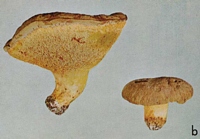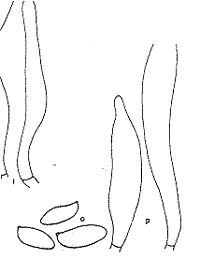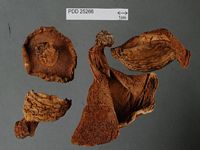|
 Boletus rawlingsii Boletus rawlingsii
BiostatusPresent in region - Indigenous. Endemic
Images (click to enlarge)
Caption: Fig. 7 - b, Boletus rawlingsii (x 2/3) | 
Caption: Boletus rawlingsii: o, spores; p, cystidia. | 
Caption: Dried type specimen
Owner: Herb PDD |
Article: McNabb, R.F.R. (1968). The Boletaceae of New Zealand. New Zealand Journal of Botany 6(2): 137-176 (http://www.rsnz.org/publish/abstracts.php).
Description: PILEUS: convex
when young, applanate at maturity, often with reflexed margins when old, 5-11.5
cm diam. dry, finely felted to subtomentose, dull yellow to greyish yellow;
cuticle a poorly organised trichodermium when young, becoming disorganised at
maturity and composed of interwoven, thin-walled, septate hyphae, terminal cells
repent, oblique, or erect, 5-8 µm diam.; margin entire, incurved, extending
beyond pores, slightly more tomentose than remainder of pileus. HYMENOPHORE:
tubes to 7 mm long, adnate to subdecurrent, pallid yellow when young, becoming
bright golden yellow at maturity; pores concolorous with tubes, often discoloured
reddish brown in places, irregularly angular, 1-1.5 mm diam.; unchanging where
damaged. STIPE: 3-5 cm long, more or less equal, 2-3.5 cm diam., solid, dry,
subglabrous to finely subvelutinate from a close palisade of caulocystidia,
occasionally faintly reticulate at extreme apex, pastel yellow or slightly darker;
flesh pallid yellow to yellow; annulus absent.
SPORES: spore print
insufficient for accurate determination, but near olive brown; spores melleous,
broadly elliptic-subfusiform, occasionally obovate, ll-13.8-(14.9) X 4.5-5.9-(6.9)
µm, smooth. HYMENIUM: basidia hyaline, clavate, 35-49 X 9.5-11.5 µm, 4-spored;
cystidia numerous, scattered, hyaline, thin-walled, ventricose-rostrate, 42-72
X 8.4-11.5 µm. HYMENOPHORAL TRAMA: bilateral of the Boletus subtype;
clamp connections absent. CONTEXT OF PILEUS: pallid yellow to yellow, unchanging
on exposure to air. TASTE: unpleasant, slightly acrid. SMELL: not distinctive.
CHEMICAL REACTIONS: KOH on pileus—darkening; on context of pileus—reddish; NH4OH
on pileus and context—no reaction.
Habitat: HABITAT: Solitary or gregarious under Leptospermum.
Notes: The xerocomoid
habit, subvelutinate stipe, medium to large pores, and cuticle composed of a
poorly organised trichodermium indicate that Boletus rawlingsii belongs
in sect. Subpruinosi as defined by Singer (1947).
The species is
named in honour of Mr. G. B. Rawlings, who first collected this fungus
and whose fieldwork on the introduced Boletaceae of this country amply deserves
recognition.
B. rawlingsii may
be recognised by the yellow fruitbodies, unchanging context and hymenophore,
and broadly elliptic-subfusiform spores.
|